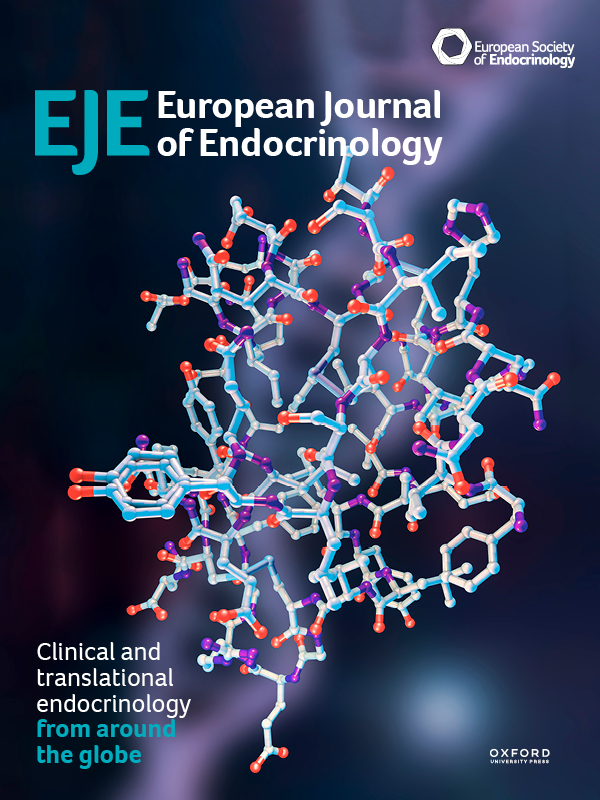早熟女孩的峰高速度取决于胰岛素,而不是脂肪量或 IGF-I。
IF 5.3
1区 医学
Q1 ENDOCRINOLOGY & METABOLISM
引用次数: 0
摘要
目的 近几十年来,青春期开始的年龄有所下降。与晚熟女孩相比,早熟女孩的青春期持续时间更长,身高峰值速度(PHV)更高。目前尚不清楚胰岛素样生长因子-I(IGF-I)、脂肪量或空腹胰岛素水平的增加在多大程度上导致了这种情况。结果早熟女孩的最终身高与晚熟女孩相似(166.1 vs 167.1 厘米,P = 0.36)。与晚熟女孩相比,早熟女孩的 PHV 明显更高(8.7 厘米/年 vs. 7.4 厘米/年,p < 0.001),青春期持续时间更长(乳房开始发育年龄与 PHV 年龄之比 [1.8 年 vs. 1.1 年,p < 0.001])。在对青春期开始年龄进行校正后,早熟和晚熟女孩的体重指数、SFT 和 IGF-I 水平均无差异。相比之下,在青春期开始后 1.5 年、2.0 年和 3.0 年,早熟女孩的空腹胰岛素水平明显高于晚熟女孩(所有 p = 0.039)。因此,较高的胰岛素水平可能会通过强化青春发育期来补偿较短的总生长期。本文章由计算机程序翻译,如有差异,请以英文原文为准。
Higher Peak Height Velocity in Early Maturing Girls Depends on Insulin rather than Fat Mass or IGF-I.
OBJECTIVE
Age at pubertal onset has decreased over the recent decades. Early maturing girls have longer puberty duration, and higher peak height velocity (PHV) than late maturing girls. To what extent this is generated by increased insulin-like growth factor-I (IGF-I), fat mass or fasting insulin levels is currently unknown.
DESIGN, SETTING, PARTICIPANTS
A population-based study - part of the COPENHAGEN puberty study - longitudinal part. Eighty-one girls evaluated biannually for a median of 10 (2-15) visits for a total of 815 evaluations.
METHODS
Pubertal staging, anthropometric measures, PHV, skin fold thickness (SFT) and IGF-I and fasting Insulin levels were measured.
RESULTS
Early maturing girls achieved similar final height compared to late maturing girls (166.1 vs 167.1 cm, p = 0.36). Early pubertal onset was associated with significantly greater PHV (8.7 vs. 7.4 cm/year, p < 0.001) and a longer puberty duration (age at onset of breast development to age at PHV [1.8 vs. 1.1 years, p < 0.001]) compared with late maturation. After correcting for age at pubertal onset, neither BMI, SFT nor IGF-I levels differed between early versus late maturing girls. By contrast, fasting insulin levels were significantly higher in early compared with late maturing girls 1.5, 2.0 and 3.0 years after pubertal onset (all p = 0.039).
CONCLUSION
Growth velocity was higher and more prolonged in early compared with late maturing girls and associated with higher insulin levels. Thus, the higher insulin levels may compensate for the shorter total growth period by intensifying the pubertal growth period.
求助全文
通过发布文献求助,成功后即可免费获取论文全文。
去求助
来源期刊

European Journal of Endocrinology
医学-内分泌学与代谢
CiteScore
9.80
自引率
3.40%
发文量
354
审稿时长
1 months
期刊介绍:
European Journal of Endocrinology is the official journal of the European Society of Endocrinology. Its predecessor journal is Acta Endocrinologica.
The journal publishes high-quality original clinical and translational research papers and reviews in paediatric and adult endocrinology, as well as clinical practice guidelines, position statements and debates. Case reports will only be considered if they represent exceptional insights or advances in clinical endocrinology.
Topics covered include, but are not limited to, Adrenal and Steroid, Bone and Mineral Metabolism, Hormones and Cancer, Pituitary and Hypothalamus, Thyroid and Reproduction. In the field of Diabetes, Obesity and Metabolism we welcome manuscripts addressing endocrine mechanisms of disease and its complications, management of obesity/diabetes in the context of other endocrine conditions, or aspects of complex disease management. Reports may encompass natural history studies, mechanistic studies, or clinical trials.
Equal consideration is given to all manuscripts in English from any country.
 求助内容:
求助内容: 应助结果提醒方式:
应助结果提醒方式:


